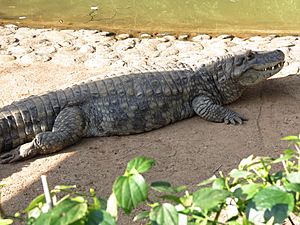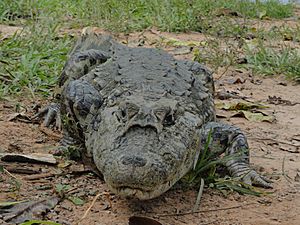Broad-snouted caiman facts for kids
Quick facts for kids Broad-snouted caiman |
|
|---|---|
 |
|
| Conservation status | |
| Scientific classification | |
| Genus: |
Caiman
|
| Species: |
latirostris
|
 |
|
| Broad-snouted caiman range | |
| Synonyms | |
|
Species synonymy
cynocephalus Dumeril & Bibron, 1836
fissipes Spix, 1825 lutescens Rovereto, 1912 sclerops Wied, 1825 |
|
The broad-snouted caiman (Caiman latirostris) is a type of crocodilian. It belongs to the Alligatoridae family, which also includes alligators. You can find these caimans in eastern and central South America. This includes places like southeastern Brazil, northern Argentina, Uruguay, Paraguay, and Bolivia.
They mostly live in freshwater areas like marshes, swamps, and mangroves. They prefer water that is still or moves very slowly. Sometimes, they even use ponds made by people for cows.
Contents
What Does the Broad-Snouted Caiman Look Like?
In the wild, adult broad-snouted caimans usually grow to be about 2 to 2.5 meters (6.5 to 8 feet) long. Some older males have been seen reaching up to 3.5 meters (11.5 feet). Caimans living in zoos can weigh between 23 to 65 kilograms (50 to 143 pounds).
Most of these caimans are a light olive-green color. Some even have spots on their faces. Their most special feature is their wide, flat snout. This is how they got their name! Their broad snout helps them move through thick plants in marshes to find food. Because of this, they might even swallow some plants while they are eating.
How Broad-Snouted Caimans Live and Behave

The broad-snouted caiman is a cold-blooded creature. This means its body temperature depends on the temperature of its surroundings. When it gets warmer, its heart beats faster. This helps spread the heat from the sun throughout its body. When it gets cooler, its heart rate slows down.
Young caimans spend a lot of time finding safe places to hide. This helps them avoid being eaten by other animals. As they get older, they don't need to hide as much.
What Do Broad-Snouted Caimans Eat?
Young broad-snouted caimans mostly eat insects. As they grow bigger, their diet changes. They start to eat more birds, fish, amphibians, and reptiles. Their strong jaws can even crush the shells of turtles and snails.
Scientists have also seen these caimans eating fruit. This suggests they might eat plants as well as animals. They could even help spread plant seeds in their homes.
Broad-Snouted Caiman Reproduction and Life Cycle
Female broad-snouted caimans lay between 18 and 50 eggs at a time. Sometimes, a nest might have as many as 129 eggs. This usually happens when more than one female lays eggs in the same nest.
They often lay their eggs in two layers. The temperature is slightly different between the two layers. This helps make sure there's a good mix of male and female babies. The temperature of the eggs determines if they will be male or female. Eggs kept at warmer temperatures (32°C or higher) usually become males. Eggs at cooler temperatures (31°C or lower) usually become females. Other things, like the mother's stress levels, can also affect the sex of the babies.
Protecting the Broad-Snouted Caiman
People started hunting broad-snouted caimans in the 1940s. Their skin was very popular because it was so smooth. Hunting was the biggest danger to these caimans until many countries made it illegal. This helped their numbers grow again.
Now, the biggest threat to broad-snouted caimans is the destruction of their homes. Cutting down forests and pollution from runoff are the main reasons their habitats are being harmed.
These caimans are well-known in the lagoons of urban areas like Barra da Tijuca and Recreio dos Bandeirantes in Rio de Janeiro.
See also
 In Spanish: Yacaré overo para niños
In Spanish: Yacaré overo para niños



